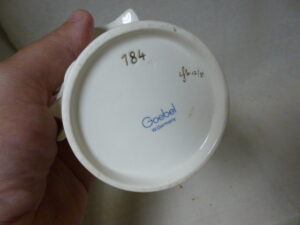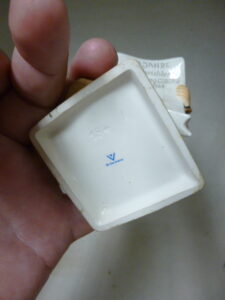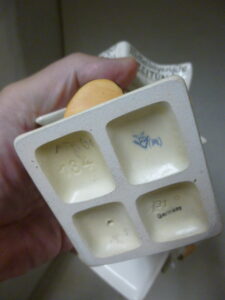 One of the important components of a good educational website is being to provide information where no other source on the Internet may readily be located. Very little has been written, that I have been able to find, for recent questions since Robert Miller’s 2006 tenth edition of his Price Guide or even Heidi Ann Von Recklinghausen’s 2013 2nd Edition of her Price Guide. With the idea of the book, “HUMMELS 1978-1998: 20 Years of “Miller On Hummel” Columns By Robert L. Miller” where Mr. Miller answered people’s questions, this page is created to offer answers from avid collectors to those questions you may have never considered but nonetheless find interesting.
One of the important components of a good educational website is being to provide information where no other source on the Internet may readily be located. Very little has been written, that I have been able to find, for recent questions since Robert Miller’s 2006 tenth edition of his Price Guide or even Heidi Ann Von Recklinghausen’s 2013 2nd Edition of her Price Guide. With the idea of the book, “HUMMELS 1978-1998: 20 Years of “Miller On Hummel” Columns By Robert L. Miller” where Mr. Miller answered people’s questions, this page is created to offer answers from avid collectors to those questions you may have never considered but nonetheless find interesting.
This page was updated on 27 October 2023.
Question: Why do some Hummel figurines have a round base whereas others have a square base? A good example where this was modified within a figurine is HUM 184 – Latest News where the base was changed from square (TMK-2 Full Bee) to a round one within the Stylized trademark (TMK-3) in the mid-1960s.


 Answer: Hummel enthusiast Wolfgang Seidl proposed the following with supporting photographs. From left to right are the TMK-2, TMK-3 and TMK-6 trademark variations for the figurine HUM 184 – Latest News. “With the figurine Hum 184 – Latest News, the first production in this time period of 1935 to 1945 required a technique to do a square base with a cross inside. This was to carry the weight of the figurine and if the base was not strong enough to hold the heavy figurine, the middle of the base might fall through. During the years following, the production team came up with new ideas and techniques and the company found they could do the square base without the supporting cross. Later, they changed it again. This time, not for the technique but rather for the design and now the figurine received a round base. The nearly 100% answered (99%) to your question is: If a base is changed, it CAN be to carry the figurine, it can be for more space and it can be for the design AND it can also correct a mistake inside the production.” – Wolfgang Seidl
Answer: Hummel enthusiast Wolfgang Seidl proposed the following with supporting photographs. From left to right are the TMK-2, TMK-3 and TMK-6 trademark variations for the figurine HUM 184 – Latest News. “With the figurine Hum 184 – Latest News, the first production in this time period of 1935 to 1945 required a technique to do a square base with a cross inside. This was to carry the weight of the figurine and if the base was not strong enough to hold the heavy figurine, the middle of the base might fall through. During the years following, the production team came up with new ideas and techniques and the company found they could do the square base without the supporting cross. Later, they changed it again. This time, not for the technique but rather for the design and now the figurine received a round base. The nearly 100% answered (99%) to your question is: If a base is changed, it CAN be to carry the figurine, it can be for more space and it can be for the design AND it can also correct a mistake inside the production.” – Wolfgang Seidl
Question: There are several other duplication examples of figurines such as the Little Fiddler in HUM 2 and HUM 4 as well as the Book Worm located as HUM 3 and HUM 8 and the ever popular Merry Wanderer found as HUM 7 and HUM 11. A later version of HUM 31 – Silent Night was renumbered HUM 54. Was there a reason for each of these duplications?
Answer: – “A new and better answer for this question, to the numbers 2 and 4 and 7 and 11, I spoke with the old archivar (the person who made the Hummel archives in the time of the Goebel company) and he told me when we spoke about very small numbers 2 to 11, this was the beginning of the company and it can be that at this time (start of the MI Hummel series, the second world war and so on) the company had not started with the size program. With the numbers 3 and 8, this is different, the most important thing for a number is to change something on a figurine, with a candleholder or with out a candleholder but by 3 and 8, it is easy because 3 is the figurine and 8 is the figurine as a bookend with a flat back.” – Wolfgang Seidl
Question: I’ve been told that the Double Crown figurines are more desirable and worth more. I would have thought that the older Crown versions with only the incised trademark would be older and worth more than the ones with the stamped Crown including those with both Crown marks.
Answer: – “About the worth of a piece, I can say nothing because the design of a figurine is, MOST OF THE TIME, why people buy the lovely Hummel figurines, BUT I can make clear why some have both trademarks and others not. Rumors in the past told us that the incised trademark was by the production prosecc and the stamp came on the figurine when it is sold to a dealer or to the collector. THIS IS WRONG. The correct version is that the incised trademark is in the mold and to these periods (only during trademarks 1 and 2, not in trademark 3 and younger) the molds are in the material of plaster and the must be cleaned during the production often, very often, because you can made only a few with each mold and a order from the head of the company was, we stamp all figurines to the incised trademark also because then we have clear information from which time period it is. This was also DURING the production process.” – Wolfgang Seidl
Question: Why do some figurines have the M I Hummel signature on the top of the base while others have the same signature on the side of the base?
Answer: –
Question: The Advent pieces HUM 115, HUM 116 and HUM 117 were produced and marketed at the same time as the almost identical MEL 1, MEL 2 and MEL 3 figurines. Each was produced in the Crown (TMK-1), Full Bee (TMK-2) and Stylized Bee (TMK-3) trademarks. What was the reason for the duplication?
Answer: –
Question: Some of the earliest figurines were created in porcelain and soon changed to earthenware. What was the deciding factor in this?
Answer: –